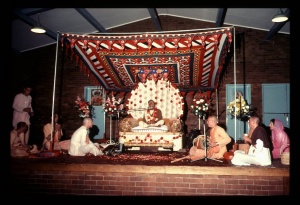CC Madhya 20.165

A.C. Bhaktivedanta Swami Prabhupada
TEXT 165
- svayaṁ-rūpa, tad-ekātma-rūpa, āveśa—nāma
- prathamei tina-rūpe rahena bhagavān
SYNONYMS
svayam-rūpa—the original form; tat-ekātma-rūpa—the same form, nondifferent from svayaṁ-rūpa; āveśa—especially empowered; nāma—named; prathamei—in the beginning; tina-rūpe—in three forms; rahena—remains; bhagavān—the Supreme Personality of Godhead.
TRANSLATION
“The Supreme Personality of Godhead exists in three principal forms—svayaṁ-rūpa, tad-ekātma-rūpa and āveśa-rūpa.
PURPORT
Śrīla Rūpa Gosvāmī has described the svayaṁ-rūpa in his Laghu-bhāgavatāmṛta, Pūrva-khaṇḍa, verse 12: ananyāpekṣi yad rūpaṁ svayaṁ-rūpaḥ sa ucyate. “The form of the Supreme Personality of Godhead that does not depend on other forms is called the svayaṁ-rūpa, the original form.” This form is also described in Śrīmad-Bhāgavatam: kṛṣṇas tu bhagavān svayam (1.3.28). “Kṛṣṇa is the original form of the Supreme Personality of Godhead.” That Kṛṣṇa’s form as a cowherd boy in Vṛndāvana is the original form of the Personality of Godhead (svayaṁ-rūpa) is confirmed in the Brahma-saṁhitā (BS 5.38):
- īśvaraḥ paramaḥ kṛṣṇaḥ sac-cid-ānanda-vigrahaḥ
- anādir ādir govindaḥ sarva-kāraṇa-kāraṇam
There is nothing superior to Govinda. He is the ultimate source and the cause of all causes. This is also confirmed in the Bhagavad-gītā (BG 7.7), where the Lord says, mattaḥ parataraṁ nānyat: “There is no truth superior to Me.”
The tad-ekātma-rūpa forms are also described in the Laghu-bhāgavatāmṛta (Pūrva-khaṇḍa, verse 14):
- yad rūpaṁ tad-abhedena svarūpeṇa virājate
- ākṛtyādibhir anyādṛk sa tad-ekātma-rūpakaḥ
“The tad-ekātma-rūpa forms exist simultaneously with the svayaṁ-rūpa form and are nondifferent. At the same time, their bodily features and specific activities appear to be different.” The tad-ekātma-rūpa forms are divided into two categories—svāṁśa and vilāsa.
Lord Kṛṣṇa’s āveśa forms are also explained in the Laghu-bhāgavatāmṛta (Pūrva 18):
- jñāna-śakty-ādi-kalayā yatrāviṣṭo janārdanaḥ
- ta āveśā nigadyante jīvā eva mahattamāḥ
“A living entity who is specifically empowered by the Lord with knowledge or strength is technically called āveśa-rūpa.” As stated in the Caitanya-caritāmṛta (CC Antya 7.11), kṛṣṇa-śakti vinā nahe tāra pravartana: Unless a devotee is specifically empowered by the Lord, he cannot preach the holy name of the Lord all over the world. This is an explanation of the word āveśa-rūpa.